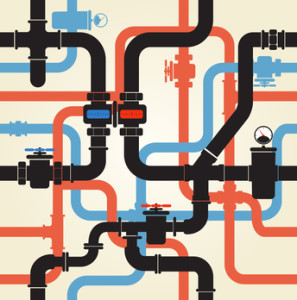Keystone XL Pipeline Myths and Facts
 7 Myths About Keystone XL, And The Real Story
7 Myths About Keystone XL, And The Real Story
In the commotion surrounding the Keystone XL pipeline project, from environmental concerns to economic claims, it’s hard to pick out the real story. Here, we address seven rumours, from the frivolous to the serious, to try to uncover the truth.
Myth: Keystone XL Exports Internationally
This myth is based on pure misinformation, but somehow it is still shared. Oddly, rumours persist that the pipeline would export oil to China, but that’s not in the plans. Keystone XL brings Canadian oil to refineries in the Gulf Coast. These refineries are locked in to long-term contracts to receive oil from Keystone XL, so the reality is that the oil will not be exported internationally.
Myth: Oil Transported by Keystone XL Will Have an Elevated Spillage Risk
This myth stems from the idea that synthetic crude and dilbit, which will be transported by the Keystone XL pipeline need to be heated or are more likely to corrode pipes, leading to spills.
In fact, the pipeline will be built to much higher safety standards than other pipelines. And it’s untrue that the oil would be more corrosive than standard crude—no heating, no major compositional changes.
Myth: Keystone XL Would Increase The Price At The Pump
This myth is mostly a misunderstanding of how oil prices actually work. Gasoline prices are determined by international, not local markets. We saw the result of that when OPEC decided to keep their production levels high and prices plummeted. It’s incredibly rare for one source to determine prices.
That said, Keystone XL has a comparable production capacity to half the current U.S. imports from the Persian Gulf. This stable source of oil could actually lower the price at the pump by making refineries less endangered by global disruptions.
Myth: Exploring the Canadian Oil Sands Will Result in Greater Greenhouse Gas Emissions
In reality, crude oil from the oil sands has very similar well-to-retail pump greenhouse gas emissions to other common sources in the U.S., such as Venezuelan crude. Furthermore, producers aren’t leaving greenhouse gas emissions from the oil sands to chance. Rather, they are actively working to improve the environmental impact of development.
Myth: Stopping Keystone Would Stop Canadian Tar Sands Exploration
This claim is pretty unlikely. The Canadian oil sands production will have a market, whether or not Americans are purchasing from it. It’s much more likely that if Keystone XL wasn’t approved, Canadian producers would just export their oil elsewhere, likely to Asian markets. In that scenario, it’s not like North Americans would stop needing oil, and would likely continue to import from distant Middle Eastern sources. Of course, all of that shipping takes energy, which means it requires oil. From that angle, stopping Keystone could actually increase overall greenhouse gas emissions as all of this oil moves around the world.
Additionally, the government doesn’t predict any change to oil sands production whether the pipeline goes ahead or not.
Myth: Low Oil Prices Have Made Keystone XL Irrelevant
This is far from the truth. Keystone XL pipeline is a part of an infrastructure to help North Americans become more oil self-sufficient, by connecting refineries and sources safely across the continent. With elevated safety measures and fewer shipping costs involved, Keystone XL remains as relevant as ever.
Myth: American Workers Don’t Benefit From the Keystone XL Pipeline
The American Petroleum Institute estimates that Keystone will create as many as 343,000 U.S. jobs in four years. Even conservative estimates from the government forecasts the creation of 42,000 jobs during the construction phase alone. Many of those will be high-wage manufacturing and construction jobs, which help families live comfortably.
In the long term, things look even better. The Canadian Energy Research Institute (CERI) estimates that oil sands activity will increase the total U.S. GDP by $210 billion over the next twenty years. Jobs look good in the long view as well, as CERI predicts 600,000 jobs could be supported by the pipeline in the same period.

